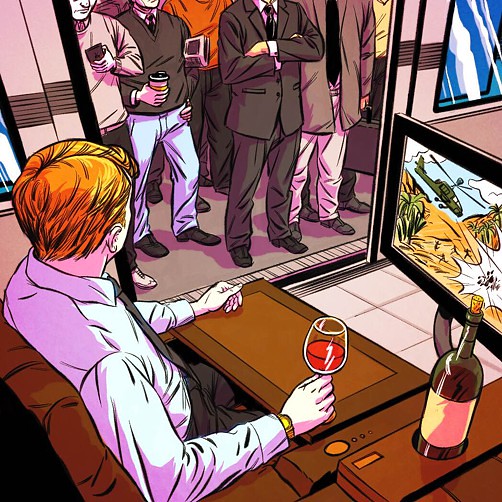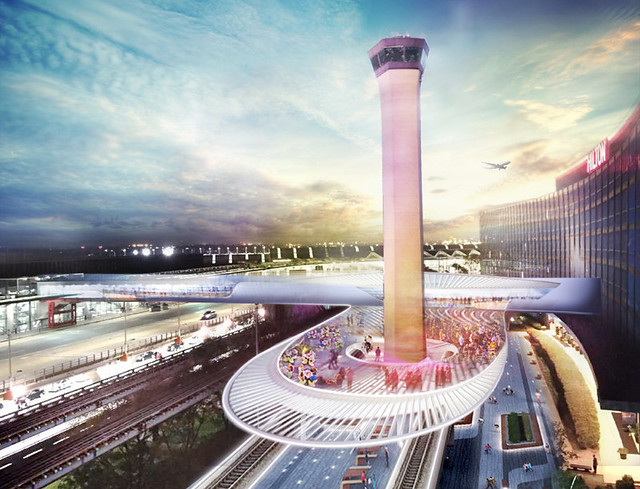[The Chicago Reader recently launched a new weekly transportation column written by Streetsblog Chicago editor John Greenfield. This partnership allows Streetsblog to extend the reach of our livable streets advocacy. We syndicate a portion of the column on the day it comes out online; you can read the remainder on the Reader’s website or in print. The paper hits the streets on Thursdays.]
With Mayor Emanuel under fire over police scandals and the schools crisis, it's a strange time for him to move forward with a plan for an airport express train aimed at well-heeled business travelers. But last week the city awarded a $2 million contract to local engineering firm Parsons Brinckerhoff to identify possible routes, station locations, and a cost estimate for pricey high-speed rail service between the Loop and O'Hare.
Some area residents are applauding the mayor's plan as a smart strategy for fueling the city's economy. Others say it's a case of misplaced priorities, and likely to be a financial disaster. Still others argue the project could be more useful and have broader appeal if done as part of the Midwest High Speed Rail Association's "CrossRail Chicago" proposal to link the airport with the southeast side.
First, some background: The O'Hare express was something of a white whale for Richard M. Daley. Stoked after experiencing high-speed rail in Shanghai, he pushed hard for the new airport line, eventually spending some $250 million on a "superstation" underneath Block 37. But the city wound up with a white elephant: that facility now sits empty, a monument to bad urban planning.
Last year Emanuel and aviation commissioner Ginger Evans announced the airport express as a top priority, claiming that it would ease congestion on the Kennedy, create jobs, and generate tax revenue. Parsons Brinckerhoff is expected to take ten months to come up with a concrete plan.
But we know that Evans has ruled out using Daley's Block 37 superstation, arguing it's "not a feasible terminus" because it would disrupt nearby CTA lines. And since the express train would require its own set of tracks, it probably won't parallel the Blue Line, which is shoehorned between lanes of the Kennedy.
It's likely the corridor for Metra's North Central Service, which currently stops on the northeast side of the airport on its way to Antioch, would be used instead. The downtown terminal would probably be Union Station, already slated for a major renovation.
The ride would likely take about 20 or 25 minutes, compared to the current 40 to 45 minutes for the Blue Line, Evans said. She estimated that an express ticket would cost between $25 and $35.
The commissioner told the Sun-Times she's confident that bankers and lawyers will pony up for a faster, plusher ride. "They want a quiet space where they can talk on the phone and pull out a laptop," she said. "They're traveling on expense accounts."
Bruce Unruh agrees. He lives in Oak Park and flies in and out of O'Hare frequently for his job as a commercial construction rep. He usually takes a cab, at an average cost of $38.
"Even if the express wouldn't benefit me very often, I'd support all public transportation options like this," he said. "Thirty dollars to and from downtown would certainly compete with taxi service, and would just plain be more [environmentally] responsible."
A 2006 CTA business plan for an airport express estimated a $1.5 billion price tag. Although a news release from the mayor's office said the goal is to avoid using taxpayer money for construction and operations, Evans conceded to the Tribune that public funds will likely be used for building the stations.
Chinese investors in search of public-private partnerships may also be interested in bankrolling the service, according to DePaul University transportation expert Joe Schwieterman. Other possible funding sources include a federal transportation infrastructure loan, or using revenue fromairport passenger facility charges.
Detractors balk at this cost, arguing that the train project would be a wasteful boondoggle. Urban planner Daniel Kay Hertz skewered the plan in a recent Chicago magazine piece.
While no one claims a $30 train ride is going to appeal to ordinary riders, Hertz argues that the service won't even attract its target ridership of people with deep pockets or expense accounts. Boosters have cited Toronto's Union Pearson Express as a model, but Hertz notes that ridership on that line has been dismal. In fact, Toronto officials announced last week that fares would be slashed from about U.S. $20 to roughly $9 in hopes of attracting more customers.







